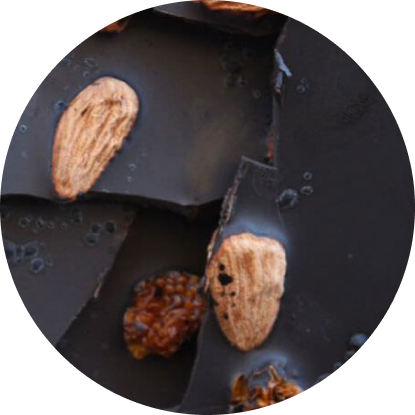RAW CACAO INSIGHTS
THE BEAUTY OF RAW CACAO AS A SUPERFOOD FOR BETTER HEALTH
View raw cacao product
Why Eat Raw Cacao?
Most of us love chocolate, but should we be eating it? Anyone who has gorged on slabs of milk chocolate will most likely have experienced weight gain, bad skin and addiction. But is there another side to this deliciously decadent food?
The deep social guilt entrenched in our relationship to chocolate is now giving way to exciting new revelations that show you can have your chocolate and eat it!
Cacao’s Healthy History
Revered by the Mayans as the food of the gods, chocolate has been used by many cultures over thousands of years. The surprising truth is it was originally used Mesoamerican people as a medicine and as money. Mayan, Olmec and Aztec cultures living between 1500BC and 400 AD were the first humans recorded to consume cacao. For these civilizations, cacao was a symbol of abundance and was often used in religious rituals. They often made a delicious drink from crushed cacao beans, mixed with water, spices, chillies and herbs. Cacao was and still is commonly known among South and Central American tribes as a medicinal carrier. When mixed with medicinal herbs it helps to enhance the effects by increasing the absorption and activation within the body.
The first Europeans to encounter cacao were travelers in the early 1600’s. During the 17th to 19th centuries in Europe accounts of the medicinal properties of cacao and chocolate included the stimulation of the nervous system and improved digestion, as well as being an effective expectorant. Antonio Lavedan claimed that chocolate was a sort of universal medicine. He found it prolonging one’s lifetime significantly as well as stimulated natural warmth and the heart, decreased flatulence, resolved constipation, helped digestion and appetite, increased virility and slowed down white hair growth. Chocolate was used to mask the bitter taste of medicines: under the name health chocolate, a wide range of drug concoctions used cacao to help promote their sales, and entire lines of chocolate-flavored medical products were produced.
In 1659 David Chaillou opened the first chocolaterie in Paris. Chaillou roasted the beans in a pan and ground them the same way the Mayans and the Aztecs did, but it wasn’t long before his technique became an outdated story. During the industrial revolution a Frenchman named Doret invented a hydraulic machine to grind cacao beans into paste. This new fandangled gadget was the first of many cacao processing machines, each one faster and hotter than the last. What they didn’t realize was how much the processing changing the nature and quality of chocolate.
THE DOWNFALL OF CHOCOLATE
By the 20th century chocolate finally lost its place as a health food: As ingredients began to change it soon found itself in the realm of junk food. The ‘fear-of-fat’ movement, which commenced in the 1970’s,demonized chocolate blaming obesity on its high-fat content. Yet the dental problems that were occurring in chocolate eaters illuminated the real link to weight gain: refined sugar. Neither of these issues made chocolate any less popular. Instead, shrouded in layers and layers of guilt, chocolate was forced underground where it found a new identity as a secret addiction. Today, nearly every ingredient found in commercial chocolate has been taken through a long, chemical induced, denaturing process.
PROCESSED CACAO
In 1828 chemist Coenraad van Houten of Holland invented a process to extract cacao butter from cacao paste separating the butter from the powder. With the modern machinery used to process cacao today (which heat the cacao to between 120 C and 150 C), as much as 90% of the flavonoids, as well as other beneficial nutrients, may be lost. The processing plants also add various synthetic chemicals such as alkalisers and acids during the process, plus most cacao beans now contain a cocktail of pesticides and fungicides.
DAIRY
The addition of milk to chocolate first occurred at the end of the 17th century. In 1876 Nestlè created condensed powdered milk, which yet again changed the taste of chocolate. Unfortunately conventional processed milk, like so many foods, is a far cry from the milk our great grandparents drank. Today milk not only contains unhealthy hormones and antibiotics, but pasteurization and homogenization rape milk of any goodness. The end result is yet another processed food.
TRANS FATS
In the 1970’s saturated fats, such as cacao butter, were suddenly deemed villainous. The once creamy element of chocolate now gave way to the new generation of solidified hydrogenated fats. Just as margarine replaced butter, hydrogenated vegetable fat replaced cacao butter, forcing chocolate to take on yet another new identity. The irony was cacao butter is incredibly healthy whereas transfats have now been found to be a major culprit in chronic disease.
SUGAR
Sugar was one of the first foods to become refined. Stripped of all its nutrients sugar soon became the offender in many addictions. With fat losing its place on the food pyramid and in the kitchen something had to replace it, and that something was sugar. What was once an added sprinkle of natural cane sugar soon became a monstrous pile of refined white poison. The flavor of cacao was nearly lost completely by the overpowering sweetness of sucrose.
CADMIUM
A naturally occurring mineral, cadmium is often present in cacao and particularly in the crops grown in soil enriched with volcanic ash. High mineral content is good, but it also means the presence of cadmium. With raw, heirloom cacao the cadmium is poorly absorbed by the body due to the presence of competing minerals, but most chocolate available is highly processed and stripped of these beneficial minerals. Read more about this here.
BACK TO BASICS
With the dawn of superfoods in the 1980’s raw, organic cacao slowly made its way back into the health food stores. This time raw, organic cacao chocolate bars, such as Soaring Free Superfoods bars make their mark by going back to the original mayan chocolate making process.
Firstly, the cacao pods are fermented for 4 to 5 days then the beans are dried. Later they are slowly conched (ground into a paste) at 40C for four days: the low temperature keeping all the minerals and phytonutrients completely intact. Later the cacao paste is melted (at 40C) and tampered with the raw cacao butter to make pure, unadulterated chocolate!
Even roasted, organic cacao is still free of the list of toxins that come along with conventional chocolates, but many phytonutrients are lost in the process.
FULL CIRCLE: KNOWN HEALTH BENEFITS TODAY
The recent rediscovery of cacao and organic chocolate has refocused the lens back onto its nutritional qualities. Thanks to the advancement in analytical technologies, the cacao’s metabolic pathways have now been properly mapped providing essential information on its roles. With multiple studies verifying the positive health effects of chocolate we are once again enjoying guilt free chocolate.
GOOD MOOD FOOD
Cacao is filled with serotonin (the happy hormone) and it’s precursor, L-tryptophan. No wonder we all crave chocolate when we are feeling a little down and out. The serotonin effect is so apparent many people are beginning to use high grade organic chocolate as a natural antidepressant. Because of its antioxidant properties, cacao also offers neural protection and enhances cognition and positive mood.
Dark chocolate increases blood flow to the brain as well as to the heart, so it can help to improve cognitive function. It contains phenylethylamine (PEA), a naturally occurring hormone like substance that acts as a neurotransmitter. It helps alertness, focus and to elevate a depressed mood. PEA amplifies the activity of major neurotransmitters for increased longevity, slower aging and increased cognitive function.
Cacao also contains theobromine, an antioxidant, which positively influences our moods and our state of alertness. Recent studies have highlighted the potential of theobromine to be anti-tumoral, anti-inflammatory and a cardiovascular protector molecule. The main mechanisms of action of theobromine are inhibition of phosphodiesterases and blockade of adenosine receptors, thus increasing the reduction of cellular oxidative stress and regulation of gene expression.
MINERALS, MUSCLES AND MENSTRUAL HEALTH
These are supported by the bioavailable minerals found in cacao. A recent study on Ghanian cacao beans found the most abundant mineral in unfermented cacao pulp was potassium (2318.7mg/100g)followed by phosphorus (381.8mg/100g), magnesium (349.2mg/100g) and calcium (142.mg/100g) which had appreciable values, then copper (15.3mg/100g), zinc (9.4 mg/100 g), sodium (2.7mg/100g)and lastly iron (1.4 mg/100 g) was still high enough to be beneficial. Most people are suffering from some level of a mineral deficiency so it is no wonder so many crave chocolate. According to research chocolate is the most craved food by women. This craving is doubled before menstruation, most likely because chocolate contains a valuable source of magnesium and other minerals needed for a healthy reproductive cycle. These minerals are also needed for healthy muscles, organs, bones and mental health.
CACAO BUTTER
It contains approximately 250mg of beta and gamma tocopherol vitamin E’s per gram. It is also packed with phospholipids and phosphosterols. In fact the plant-based saturated fat is in fact an easily absorbable, much needed brain food.One third of the fat content in cacao butter is composed of stearic acid. Unlike saturated fat from animals, stearic acid has no negative impact on cholesterol levels.
ANTIOXIDANTS
The polyphenols found in cacao may thus protect against diseases in which oxidative stress is implicated as a causal or contributing factor.The antioxidant properties of cacao polyphenols endow them with various positive effects against several pathological disorders, including cardiovascular disease, inflammatory processes, metabolic disorders, and cancer. It has been demonstrated that polyphenols cause nonapoptotic cell death, blocking the cell cycle in the G2/M phase, which potentiates their antiproliferative effects. They also have antiproliferative, antimutagenic, and chemoprotective effects, in addition to their anticariogenic effects.
HEART HEALTH
The heart is supported by raw chocolate’s rich dietary source of polyphenols. Several studies have found the dietary intake of polyphenols from cacao have a beneficial effect on vascular health. Recent reports indicate that this flavonoids has a variety of beneficial actions on cardiovascular health, including antioxidant protection, anti-inflammatory qualities, anti-atherogenic activity and modulation of vascular homeostasis. The phenolics from cacao modify the lipid profile, decreasing platelet function and inflammation along with diastolic and systolic arterial pressures, which, taken together, may reduce the risk of cardiovascular mortality.
Cacao has a great trace mineral content, which help support vascular tone. Cacao polyphenols increase endothelial nitric oxide concentrations, improve vascular function, and decrease platelet adhesion. Plus the anti-inflammatory compounds have been found to decrease inflammation in cardiovascular tissue.Therefore multiple components in chocolate, particularly flavonoids, can contribute to a strong healthy heart.
GUT AND IMMUNE HEALTH
These appear to be boosted by cacao’s beneficial action on the gut microbiome. When looking at the immune system we discover that 80% of it lies within the bacteria in the gut. Most traditional medicines speak about health starting in the gut; and if we look at the nature of the bacteria we begin to understand why. These tiny microscopic entities are not only in charge of our immune system but they also make hormones, balance the nervous system and up-regulate our DNA. Therefore feeding our good bacteria is of primary important to all aspects of health. Cacao polyphenols can also modulate intestinal inflammation (through the reduction of neutrophil infiltration and expression of different transcription factors), which leads to decreases in the production of pro-inflammatory enzymes and cytokines.
According to Science Daily Bifidobacterium and lactic acid bacteria, feast on chocolate! Combining the fiber in cacao with prebiotics helps to convert polyphenolics into anti-inflammatory compounds in the stomach. Ingesting prebiotics increases the beneficial gut microbes, thus decreasing undesirable microbes in the gut. One could enhance the health benefits by combining chocolate with wild, low sugar fruits like pomegranates and acai.
INSULIN RESISTANCE, ALLERGIES AND LIFESTYLE DISEASES
Support for these ailments can be gained from the benefits from the immune regulating, anti-inflammatory, neuroprotective andantioxidant effects of cacao according to recent research. The phenolics from cacao also modify the glycemic response helping to stabilize blood sugar levels.
“Cocoa helps in weight loss by improving mitochondrial biogenesis. It increases muscle glucose uptake by inserting glucose transporter 4 in skeletal muscles membrane. It lowers immunoglobulin E release in allergic responses. It can affect the immune response and bacterial growth at intestinal levels. It reduces inflammation by inhibiting nuclear factor-κB. Keeping in view the pleiotropic health benefits of cacao, it may have the potential to be used for the prevention/treatment of allergies, cancers, oxidative injuries, inflammatory conditions, anxiety, hyperglycemia, and insulin resistance.”
Another study suggests regular consumption of cacao flavanols might be effective in improving insulin resistance, blood pressure and cognitive function.
CANCER
Cancer protocols can benefit from the antioxidant properties of cacao polyphenols according to a recent study. Polyphenols have an anti-inflammatory action which helps irritable bowel syndrome (IBD) through the inhibition of cytokines. These actions produce chemo preventive effects on chronic diseases such as cancer by inhibiting the growth of various cancer cell lines. Of special interest are the effects of polyphenols on colon cancer. The protective effects of polyphenols on IBD helps to prevent it from evolving into cancer. In addition, it has been demonstrated that polyphenols cause nonapoptotic cell death, blocking the cell cycle in the G2/M phase, which potentiates their anti-proliferative effects. A recent study shows a cacao-rich diet may inhibit the early stage of colon carcinogenesis probably by preventing oxidative stress and cell proliferation and by inducing apoptosis.
NO MATTER WHAT FLAVOUR TICKLES YOUR FANCY, WE NOW HAVE ACCESS TO THE HIGHEST QUALITY ORGANIC RAW AND COOKED CHOCOLATE THAT ARE CLEARLY MEDICINE FOR THE HEART AND SOUL.
References
- http://thechocolatejournalist.com/cadmium-chocolate/
- https://www.ictsd.org/bridges-news/bridges/news/eu-regulation-on-cadmium-in-chocolate-fuels-wto-debate-on-health
- https://www.futurity.org/cadmium-cocoa-beans-chocolate-1287742-2/
- https://www.worldcocoafoundation.org/blog/the-impacts-of-new-eu-cadmium-regulations-on-the-cocoa-supply-chain/
- http://www.berkeleywellness.com/healthy-eating/food-safety/article/there-cadmium-your-cocoa
- https://www.emeraldinsight.com/doi/abs/10.1108/EEMCS-06-2017-0127?mbSc=1&fullSc=1&journalCode=eemcs



